Big Data Analysis for Travel Time Characterization in Public Transportation Systems †
Abstract
:1. Introduction
2. Travel Time Characterization in Public Transportation Systems
3. Related Work
4. The Proposed Case Study: Public Transportation in Montevideo, Uruguay
5. Methodology
5.1. Data Repositories
5.1.1. Ticket Sales
- tripId, an identifier for specific trips within a given month. A trip is defined as the trajectory made by a given passenger with a single smart card or cash payment;
- withCard, identifying whether or not the trip was paid for using a smart card;
- dateTime, the date and time the ticket was sold;
- tripType, discriminates between trip types, e.g., one hour, two hours, etc.) and user groups (e.g., normal users, students, retirees, etc.);
- originStop, identifies the bus stop of origin;
- line, identifies the bus line;
- variant, identifies the line variant.
5.1.2. GPS Location Data
- line_id, the identifier of the bus line;
- trip_id, the identifier of the trip, allowing trips within a line to be differentiated;
- departing_time, the time of departure (fixed schedule);
- (lat, long), the GPS coordinates of the registered measurement in the EPSG 32721 reference system;
- timestamp, the timestamp of the measurement in YYYY-MM-DD HH:MM:SS format.
5.1.3. Infrastructure and Current Timetable Data
- stopUbicCode, a unique identifier for each bus stop;
- street and corner, which establish the geographical location of each bus stop;
- coordinates (X,Y), the latitude and longitude of the bus stop in the EPSG 32721 coordinate system.
- dayType, a numerical code indicating the day, with 1 representing Monday–Friday, 2 representing Saturday, and 3 representing Sunday);
- variantCode, a code identifying each variant of the line;
- headway, the time between consecutive departures of buses (in minutes);
- stopUbicCode, a code to identify each a bus stop;
- hour, the scheduled time at which the bus passes by each stop.
5.2. Metrics
5.2.1. Delay: Difference between the Scheduled and Real Travel Times
5.2.2. OTAR: On-Time Arrival Rate
5.2.3. OS: Operational Speed
5.2.4. ATToA: Additional Travel Time over Automobile
6. Data Processing
6.1. Ticket Sales Data
6.1.1. Overall Algorithmic Approach
| Algorithm 1 General processing of ticket sales data |
Input: conf_file ▹Configuration file with parameterization
|
6.1.2. Parallel Computation
6.1.3. Algorithmic Details: Logic for Processing
| Algorithm 2 Auxiliary get_stops_in_avenue function |
| Input: avenues_set: set of avenues considered in the analysis Output: result_dict: key is the bus stop code and values are the number of tickets sold, the street where the stop is located, and the secondary street
|
| Algorithm 3 Function compute_headway |
| Input: weekly scheduled trips for the busiest stops (dictionary) Output: input dictionary expanded with the headway, an extra field that indicates the time interval between consecutive trips of buses of each line (dictionary)
|
| Algorithm 4 Function estimate_delay |
| Input: monthly trips Input: dictionary with weekly scheduled trips for the busiest stops Output: dictionary storing the computed delay for each trip
|
6.1.4. GPS Data
7. Analysis and Discussion of Results
7.1. Analysis of Ticket Sales Data
7.1.1. Delay in Rush Hours vs. Delays in Non-Peak Hours
7.1.2. Delay on Weekdays vs. Delay on Weekends
7.1.3. Distribution of Delays over the Course of the Day for Weekdays and Weekends
7.1.4. Analysis of Specific Bus Lines
7.1.5. On-Time Arrival Rate
7.1.6. Analysis of GPS Records
7.2. Deviations from the Scheduled Travel Times
7.3. Operational Speed
7.4. On-Time Arrival Rate
7.5. Additional Travel Time over Automobile
8. Conclusions
Author Contributions
Funding
Institutional Review Board Statement
Informed Consent Statement
Data Availability Statement
Conflicts of Interest
References
- Cardozo, O.D.; Rey, C.E. La vulnerabilidad en la movilidad urbana: Aportes teóricos y metodológicos. In Aportes Conceptuales y Empíricos de la Vulnerabilidad Global; Foschiatti, A., Ed.; Editorial Universitaria de la Universidad Nacional del Nordeste: Corrientes, Argentina, 2007; pp. 398–423. [Google Scholar]
- Grava, S. Urban Transportation Systems; McGraw-Hill Professional: New York, NY, USA, 2000. [Google Scholar]
- U.S. Census Bureau. American Community Survey 2021 Data Release. 2021. Available online: https://www.census.gov/programs-surveys/acs.html (accessed on 15 July 2023).
- Hipogrosso, S.; Nesmachnow, S. A Practical Approach for Sustainable Transit Oriented Development in Montevideo, Uruguay. In Smart Cities; Springer: Berlin/Heidelberg, Germany, 2022; pp. 256–270. [Google Scholar]
- Nesmachnow, S.; Hipogrosso, S. Transit oriented development analysis of Parque Rodó neighborhood, Montevideo, Uruguay. World Dev. Sustain. 2022, 1, 100017. [Google Scholar] [CrossRef]
- Frank, L.; Bradley, M.; Kavage, S.; Chapman, J.; Lawton, T.K. Urban form, travel time, and cost relationships with tour complexity and mode choice. Transportation 2007, 35, 37–54. [Google Scholar] [CrossRef]
- Salonen, M.; Toivonen, T. Modelling travel time in urban networks: Comparable measures for private car and public transport. J. Transp. Geogr. 2013, 31, 143–153. [Google Scholar] [CrossRef]
- Liu, X.; Qu, X.; Ma, X. Improving flex-route transit services with modular autonomous vehicles. Transp. Res. Part E Logist. Transp. Rev. 2021, 149, 102331. [Google Scholar] [CrossRef]
- Comi, A.; Nuzzolo, A.; Brinchi, S.; Verghini, R. Bus travel time variability: Some experimental evidences. Transp. Res. Procedia 2017, 27, 101–108. [Google Scholar] [CrossRef]
- Müller, M.; Rückert, R.; Schiewe, A.; Schöbel, A. Estimating the robustness of public transport schedules using machine learning. Transp. Res. Part C Emerg. Technol. 2022, 137, 103566. [Google Scholar] [CrossRef]
- Spiegelhalter, D. Introducing The Art of Statistics: How to Learn from Data. Numeracy 2020, 13, 7. [Google Scholar] [CrossRef]
- Massobrio, R.; Nesmachnow, S. Urban Mobility Data Analysis for Public Transportation Systems: A Case Study in Montevideo, Uruguay. Appl. Sci. 2020, 10, 5400. [Google Scholar] [CrossRef]
- Lin, D.; Cui, J. Transport and Mobility Needs for an Ageing Society from a Policy Perspective: Review and Implications. Int. J. Environ. Res. Public Health 2021, 18, 11802. [Google Scholar] [CrossRef]
- Sze, N.; Christensen, K. Access to urban transportation system for individuals with disabilities. IATSS Res. 2017, 41, 66–73. [Google Scholar] [CrossRef]
- Bhat, C.; Guo, J.; Sen, S.; Weston, L. Measuring Access to Public Transportation Services: Review of Customer-Oriented Transit Performance Measures and Methods of Transit Submarket Identification; Technical Report 0-5178-1; Center for Transportation Research, The University of Texas at Austin: Austin, TX, USA, 2005. [Google Scholar]
- Turnquist, M.; Blume, S. Evaluating potential effectiveness of headway control strategies for transit systems. Transp. Res. Rec. 1980, 746, 25–29. [Google Scholar]
- Büchel, B.; Corman, F. Review on Statistical Modeling of Travel Time Variability for Road-Based Public Transport. Front. Built Environ. 2020, 6, 70. [Google Scholar] [CrossRef]
- Zhou, M.; Wang, D.; Li, Q.; Yue, Y.; Tu, W.; Cao, R. Impacts of weather on public transport ridership: Results from mining data from different sources. Transp. Res. Part C Emerg. Technol. 2017, 75, 17–29. [Google Scholar] [CrossRef]
- Wu, J.; Du, B.; Gong, Z.; Wu, Q.; Shen, J.; Zhou, L.; Cai, C. A GTFS data acquisition and processing framework and its application to train delay prediction. Int. J. Transp. Sci. Technol. 2023, 12, 201–216. [Google Scholar] [CrossRef]
- Chan, W.C.; Ibrahim, W.H.W.; Lo, M.C.; Suaidi, M.K.; Ha, S.T. Sustainability of Public Transportation: An Examination of User Behavior to Real-Time GPS Tracking Application. Sustainability 2020, 12, 9541. [Google Scholar] [CrossRef]
- Yang, X.; Stewart, K.; Tang, L.; Xie, Z.; Li, Q. A Review of GPS Trajectories Classification Based on Transportation Mode. Sensors 2018, 18, 3741. [Google Scholar] [CrossRef]
- Mazloumi, E.; Currie, G.; Rose, G. Using GPS Data to Gain Insight into Public Transport Travel Time Variability. J. Transp. Eng. 2010, 136, 623–631. [Google Scholar] [CrossRef]
- He, S.; Miller, E.; Scott, D. Big data and travel behaviour. Travel Behav. Soc. 2018, 11, 119–120. [Google Scholar] [CrossRef]
- Wang, C.; Hess, D. Role of Urban Big Data in Travel Behavior Research. Transp. Res. Rec. J. Transp. Res. Board 2020, 2675, 222–233. [Google Scholar] [CrossRef]
- Zheng, X.; Chen, W.; Wang, P.; Shen, D.; Chen, S.; Wang, X.; Zhang, Q.; Yang, L. Big Data for Social Transportation. IEEE Trans. Intell. Transport. Syst. 2016, 17, 620–630. [Google Scholar] [CrossRef]
- Welch, T.F.; Widita, A. Big data in public transportation: A review of sources and methods. Transp. Rev. 2019, 39, 795–818. [Google Scholar] [CrossRef]
- Harsha, M.; Mulangi, R.H.; Kumar, H.D. Analysis of Bus Travel Time Variability using Automatic Vehicle Location Data. Transp. Res. Procedia 2020, 48, 3283–3298. [Google Scholar] [CrossRef]
- Kujala, R.; Weckström, C.; Mladenović, M.N.; Saramäki, J. Travel times and transfers in public transport: Comprehensive accessibility analysis based on Pareto-optimal journeys. Comput. Environ. Urban Syst. 2018, 67, 41–54. [Google Scholar] [CrossRef]
- Lei, T.L.; Church, R.L. Mapping transit-based access: Integrating GIS, routes and schedules. Int. J. Geogr. Inf. Sci. 2010, 24, 283–304. [Google Scholar] [CrossRef]
- Massobrio, R.; Nesmachnow, S.; Tchernykh, A.; Avetisyan, A.; Radchenko, G. Towards a Cloud Computing Paradigm for Big Data Analysis in Smart Cities. Program. Comput. Softw. 2018, 44, 181–189. [Google Scholar] [CrossRef]
- Massobrio, R.; Pías, A.; Vázquez, N.; Nesmachnow, S. Map-Reduce for Processing GPS Data from Public Transport in Montevideo, Uruguay. In Proceedings of the Simposio Argentino de Grandes Datos, 45 Jornadas Argentinas de Informática, Buenos Aires, Argentina, 5–9 September 2016; pp. 41–54. [Google Scholar]
- Hernández, D.; Hansz, M.; Massobrio, R. Job accessibility through public transport and unemployment in Latin America: The case of Montevideo (Uruguay). J. Transp. Geogr. 2020, 85, 102742. [Google Scholar] [CrossRef]
- Nesmachnow, S.; Risso, C. Exact and Evolutionary Algorithms for Synchronization of Public Transportation Timetables Considering Extended Transfer Zones. Appl. Sci. 2021, 11, 7138. [Google Scholar] [CrossRef]
- Denis, J.; Massobrio, R.; Nesmachnow, S.; Cristóbal, A.; Tchernykh, A.; Meneses, E. Parallel Computing for Processing Data from Intelligent Transportation Systems. In Communications in Computer and Information Science; Springer International Publishing: Berlin/Heidelberg, Germany, 2019; pp. 266–281. [Google Scholar]
- Fabbiani, E.; Nesmachnow, S.; Toutouh, J.; Tchernykh, A.; Avetisyan, A.; Radchenko, G.I. Analysis of Mobility Patterns for Public Transportation and Bus Stops Relocation. Program. Comput. Softw. 2018, 44, 508–525. [Google Scholar] [CrossRef]
- Massobrio, R.; Nesmachnow, S. Travel Time Estimation in Public Transportation Using Bus Location Data. In Smart Cities; Springer International Publishing: Berlin/Heidelberg, Germany, 2022; pp. 192–206. [Google Scholar]
- Arnott, R.; De Palma, A.; Lindsey, R. Schedule delay and departure time decisions with heterogeneous commuters. Transp. Res. Rec. 1988, 1197, 56–67. [Google Scholar]
- Kutlimuratov, K.; Mukhitdinov, A. Impact of stops for bus delays on routes. IOP Conf. Ser. Earth Environ. Sci. 2020, 614, 012084. [Google Scholar] [CrossRef]
- Federal Highway Administration. Travel Time Reliability: Making It There on Time, All the Time; Technical Report HOP-06-070; U.S. Department of Transportation: Washington, DC, USA, 2005. [Google Scholar]
- Lu, C.F. A discussion on technologies for improving the operational speed of high-speed railway networks. Transp. Saf. Environ. 2019, 1, 22–36. [Google Scholar] [CrossRef]
- Deng, Y.; Yan, Y. Evaluating Route and Frequency Design of Bus Lines Based on Data Envelopment Analysis with Network Epsilon-Based Measures. J. Adv. Transp. 2019, 2019, 5024253. [Google Scholar] [CrossRef]
- Benn, H. Bus Route Evaluation Standards A Synthesis of Transit Practice; Technical Report TCRP Synthesis 10; Transportation Research Board: Washington, DC, USA, 1995. [Google Scholar]
- Jagadeesh, G.R.; Srikanthan, T.; Zhang, X.D. A Map Matching Method for GPS Based Real-Time Vehicle Location. J. Navig. 2004, 57, 429–440. [Google Scholar] [CrossRef]
- Mishalani, R.; McCord, M.; Wirtz, J. Passenger Wait Time Perceptions at Bus Stops: Empirical Results and Impact on Evaluating Real—Time Bus Arrival Information. J. Public Transp. 2006, 9, 89–106. [Google Scholar] [CrossRef]
- Fan, Y.; Guthrie, A.; Levinson, D. Waiting time perceptions at transit stops and stations: Effects of basic amenities, gender, and security. Transp. Res. Part A Policy Pract. 2016, 88, 251–264. [Google Scholar] [CrossRef]
- Risso, C.; Nesmachnow, S.; Rossit, D. Smart Mobility for Public Transportation Systems: Improved Bus Timetabling for Synchronizing Transfers. In Smart Cities; Springer: Cham, Switzerland, 2023; pp. 158–172. [Google Scholar]
- Cao, N.; Tang, T.; Gao, C. Multiperiod Transfer Synchronization for Cross-Platform Transfer in an Urban Rail Transit System. Symmetry 2020, 12, 1665. [Google Scholar] [CrossRef]
- Peña, D.; Massobrio, R.; Dorronsoro, B.; Nesmachnow, S.; Ruiz, P. Designing a Sustainable Bus Transport System with High QoS Using Computational Intelligence. In Encyclopedia of Sustainable Technologies; Elsevier: Amsterdam, The Netherlands, 2022. [Google Scholar]
- Dalla Chiara, B.; Pede, G.; Deflorio, F.; Zanini, M. Electrifying Buses for Public Transport: Boundaries with a Performance Analysis Based on Method and Experience. Sustainability 2023, 15, 14082. [Google Scholar] [CrossRef]
- Hipogrosso, S.; Nesmachnow, S. Analysis of Sustainable Public Transportation and Mobility Recommendations for Montevideo and Parque Rodó Neighborhood. Smart Cities 2020, 3, 479–510. [Google Scholar] [CrossRef]
- Hermelin, B.; Henriksson, M. Transport and Mobility Planning for Sustainable Development. Plan. Pract. Res. 2022, 37, 527–531. [Google Scholar] [CrossRef]
- Wu, J.; Pu, C.; Ding, S.; Cao, G.; Xia, C.; Pardalos, P.M. Multi-Objective Optimization of Transport Processes on Complex Networks. IEEE Trans. Netw. Sci. Eng. 2023, 10, 780–794. [Google Scholar] [CrossRef]
- Dou, X.; Li, T. Multi-Objective Bus Timetable Coordination Considering Travel Time Uncertainty. Processes 2023, 11, 574. [Google Scholar] [CrossRef]
- Zhao, D.; Li, L.; Peng, H.; Luo, Q.; Yang, Y. Multiple routes transmitted epidemics on multiplex networks. Phys. Lett. A 2014, 378, 770–776. [Google Scholar] [CrossRef]
- Basso, F.; Frez, J.; Martínez, L.; Pezoa, R.; Varas, M. Accessibility to opportunities based on public transport gps-monitored data: The case of Santiago, Chile. Travel Behav. Soc. 2020, 21, 140–153. [Google Scholar] [CrossRef]

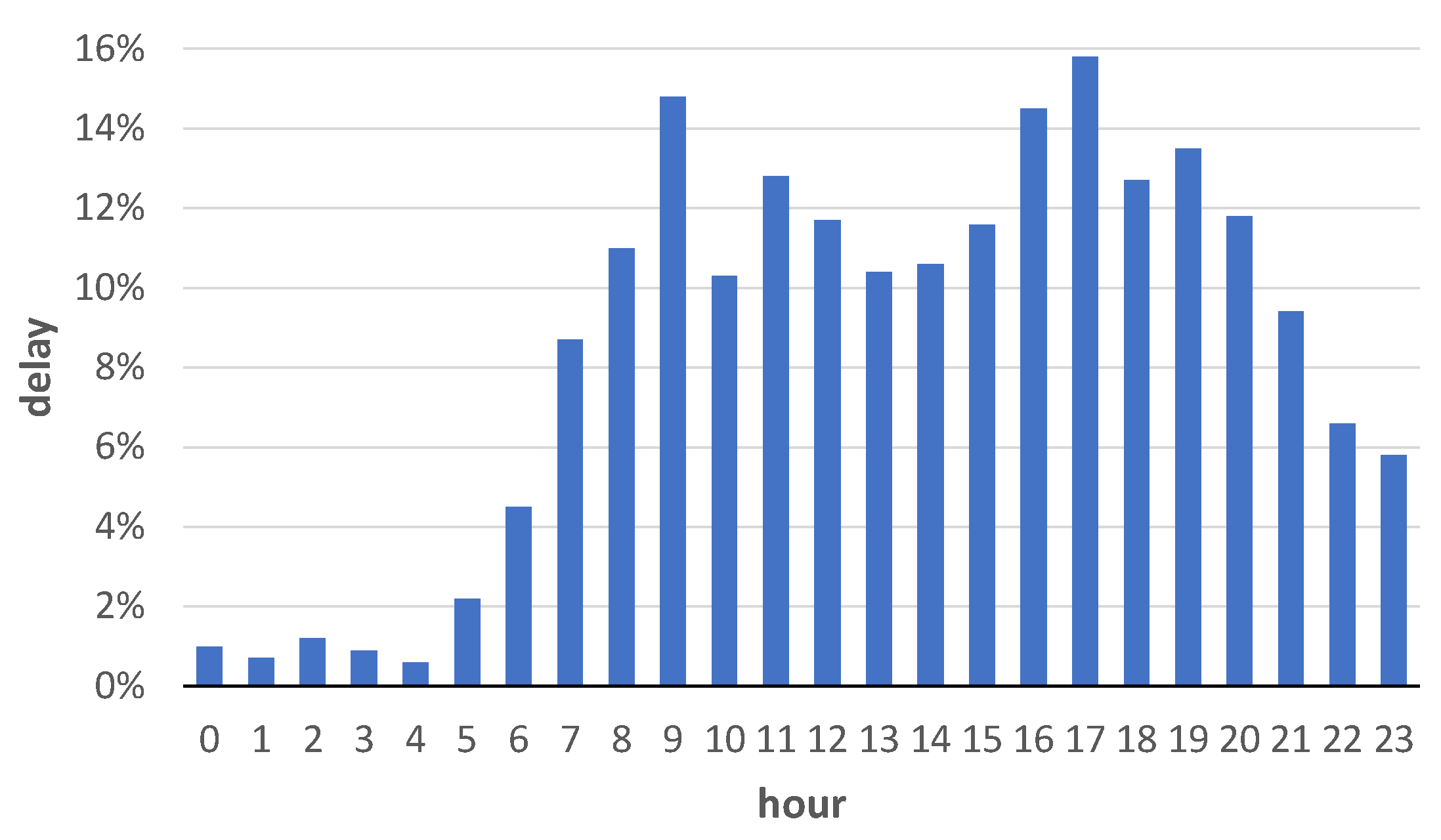
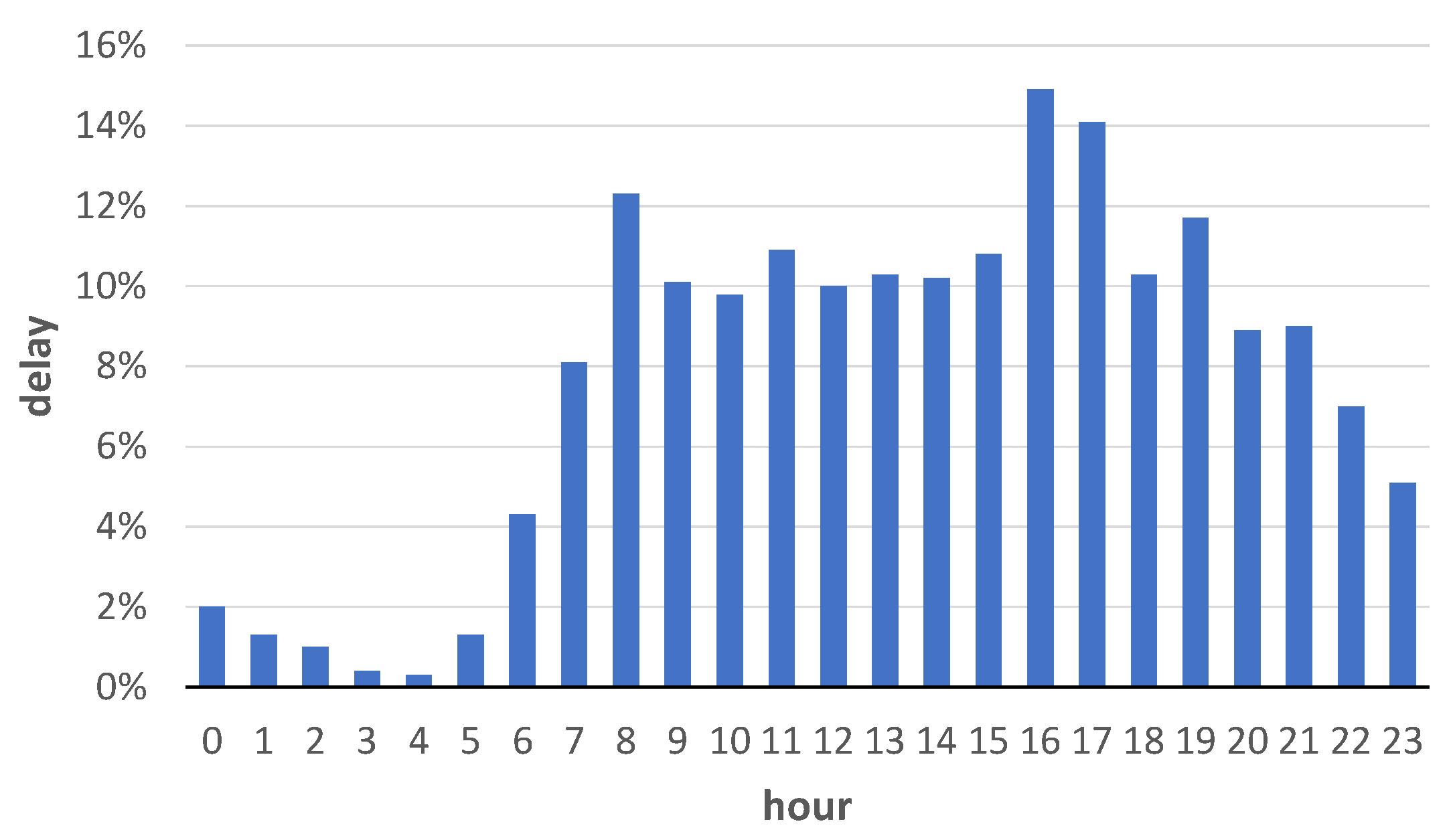

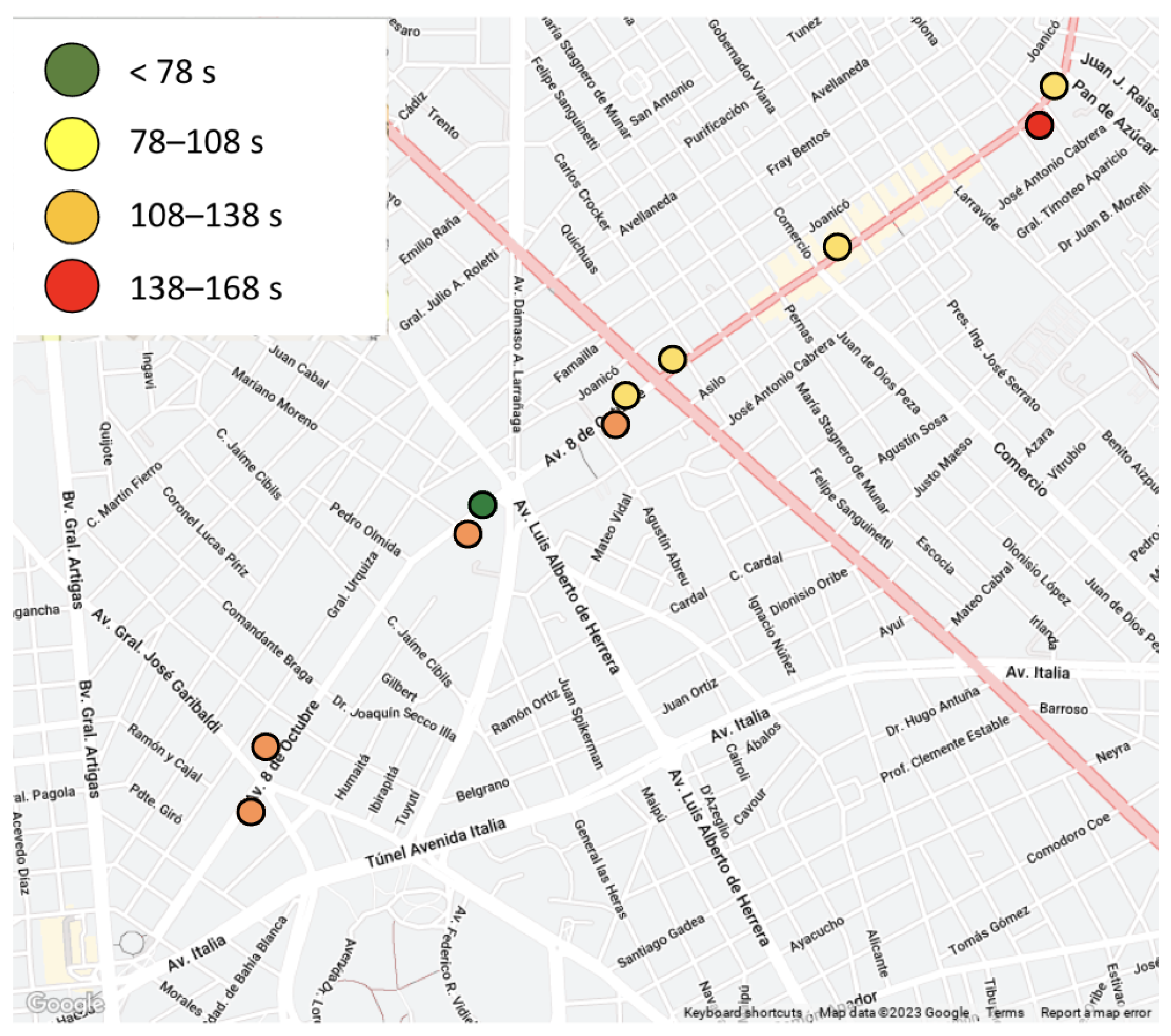
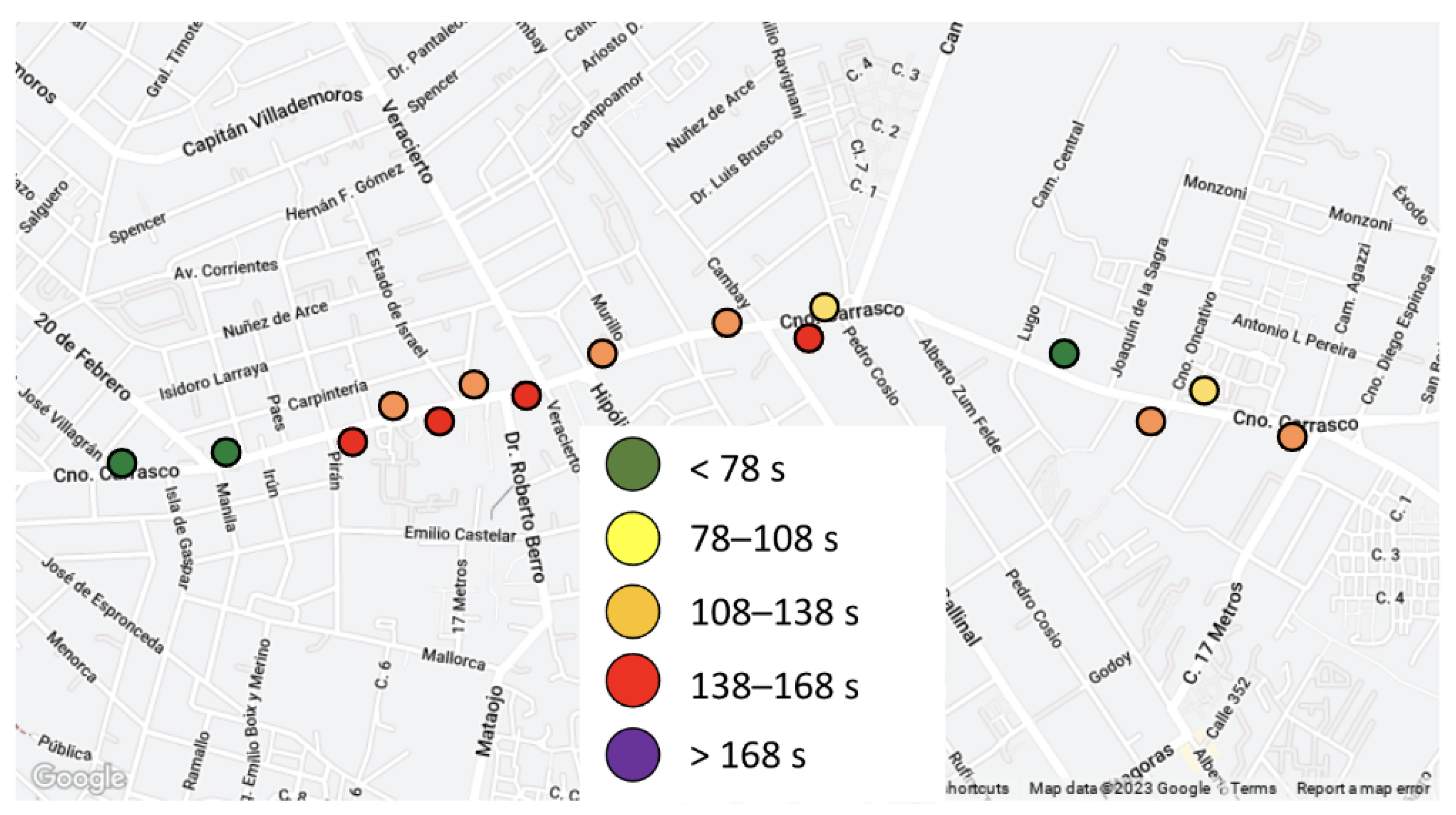

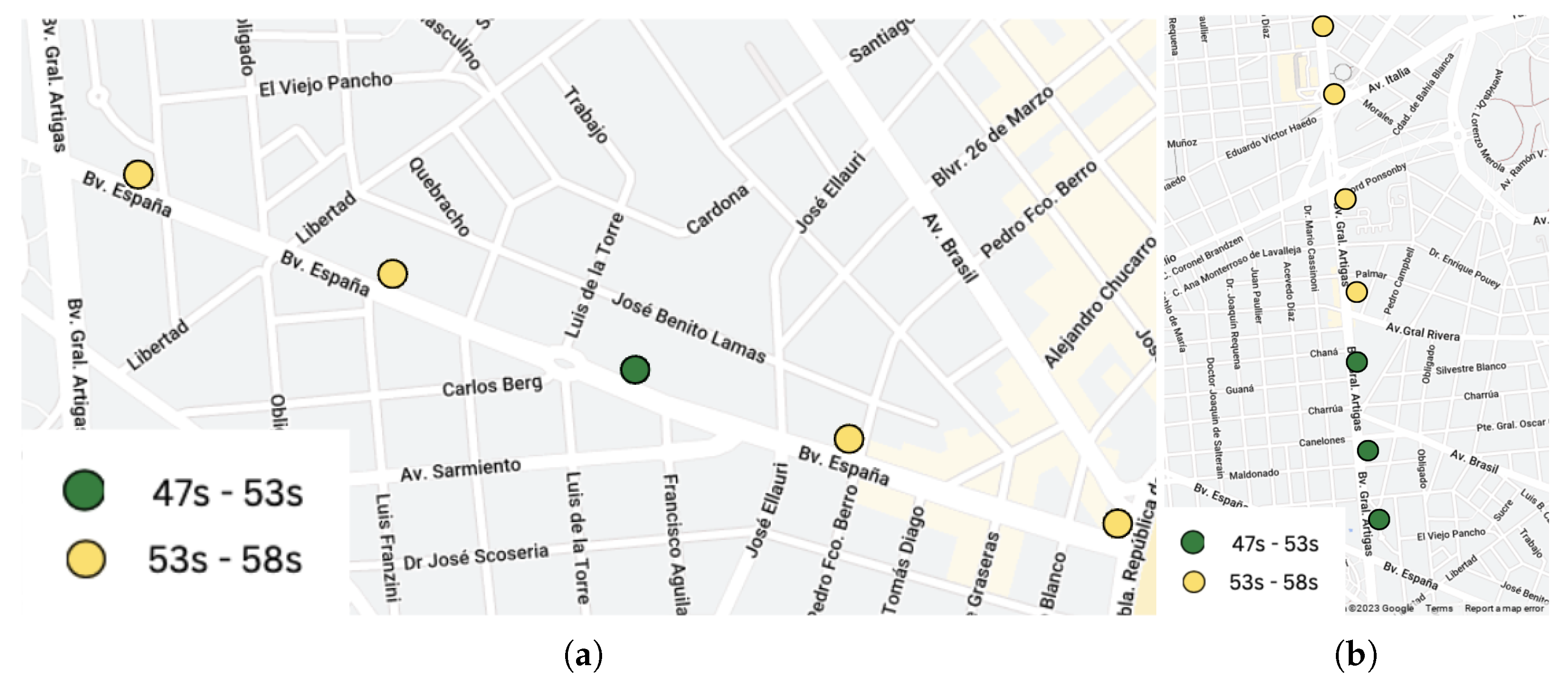
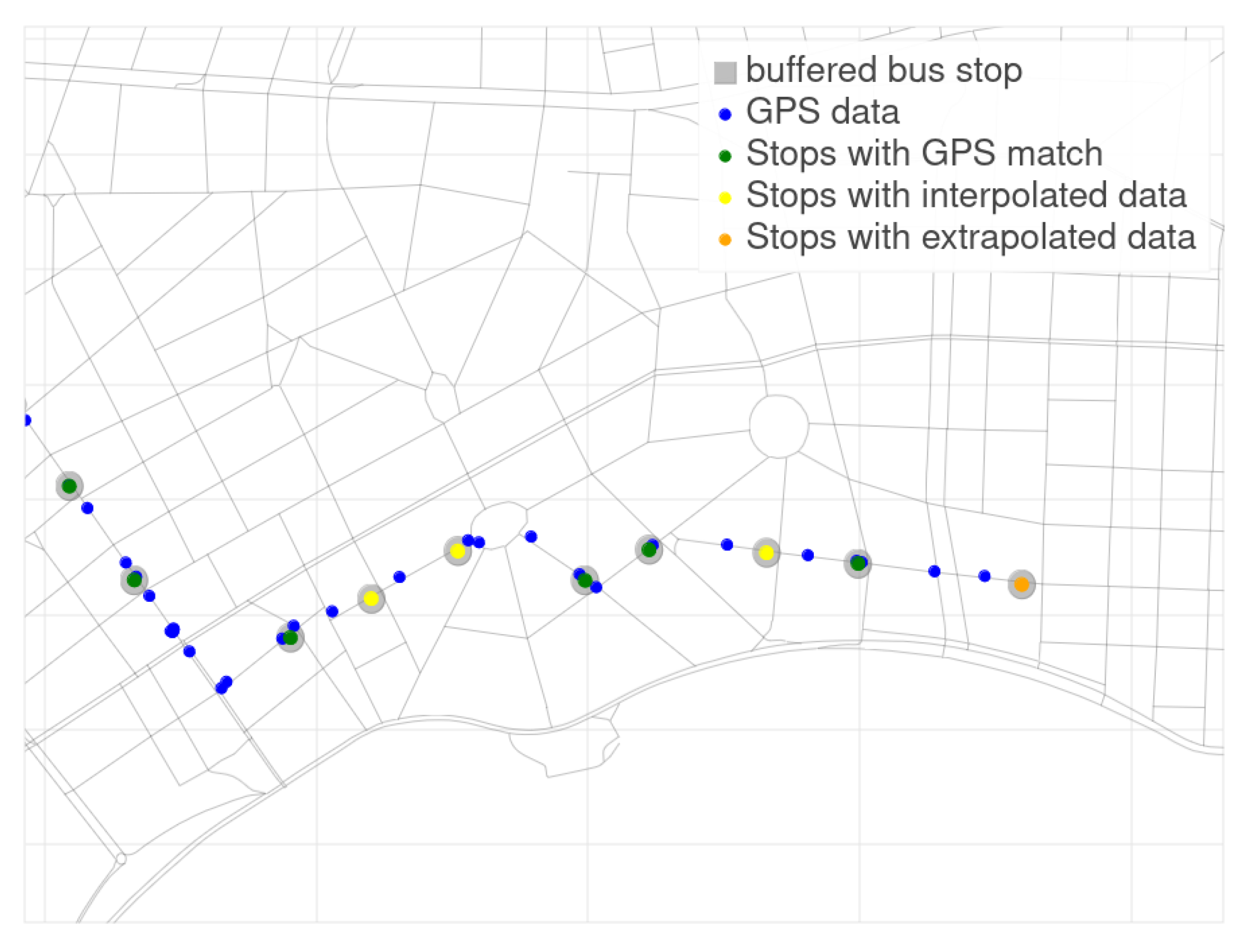
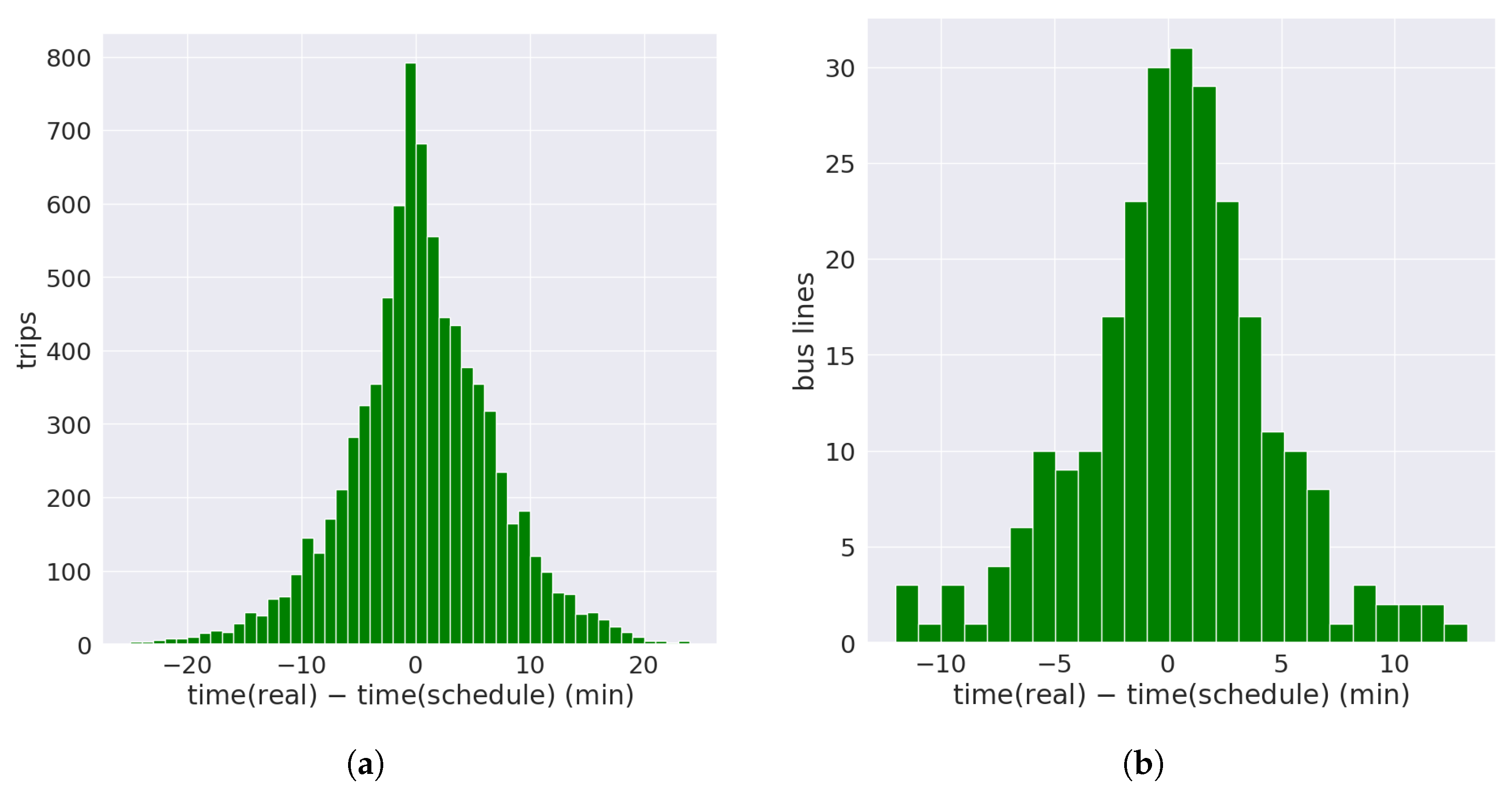
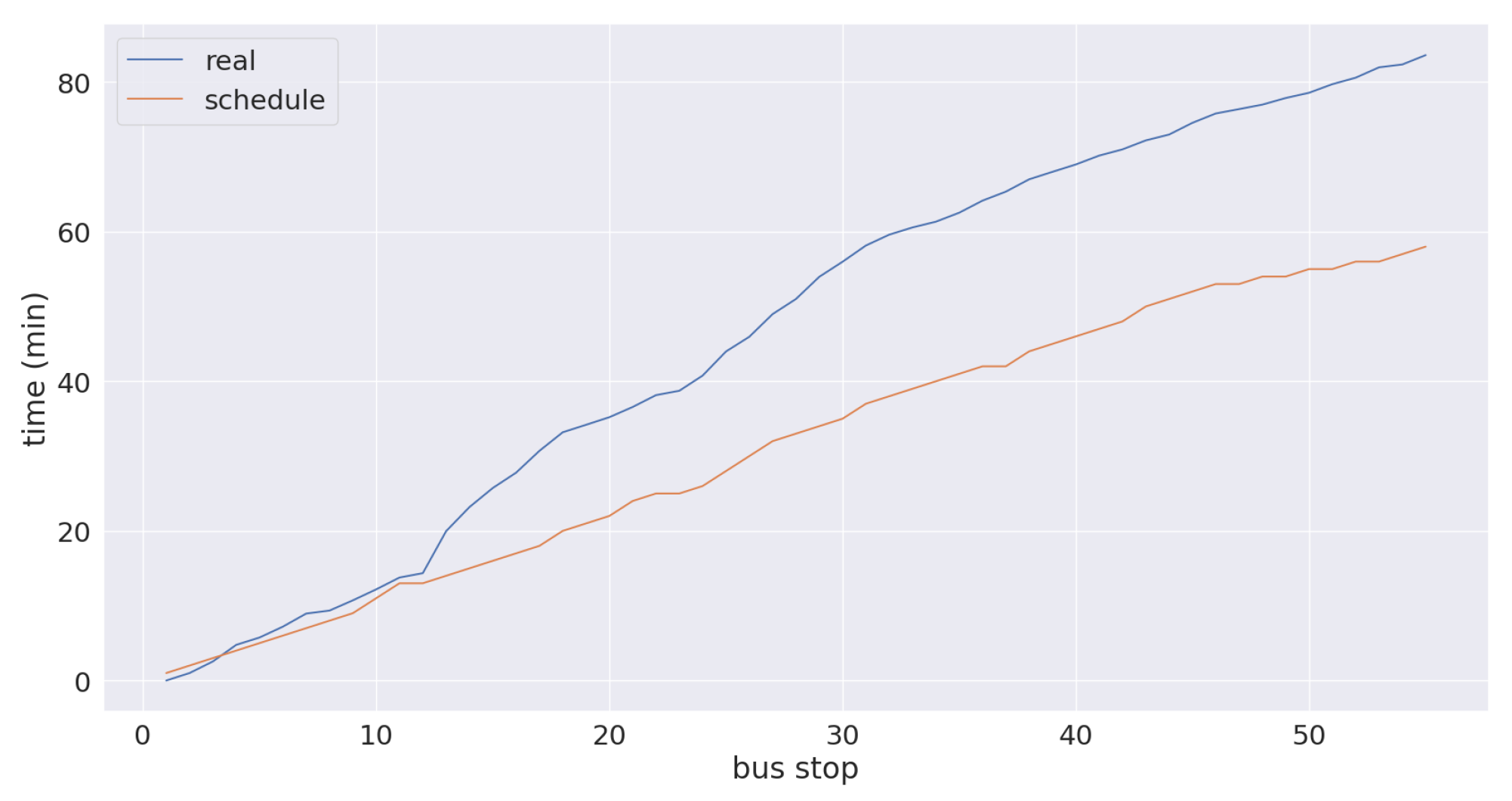
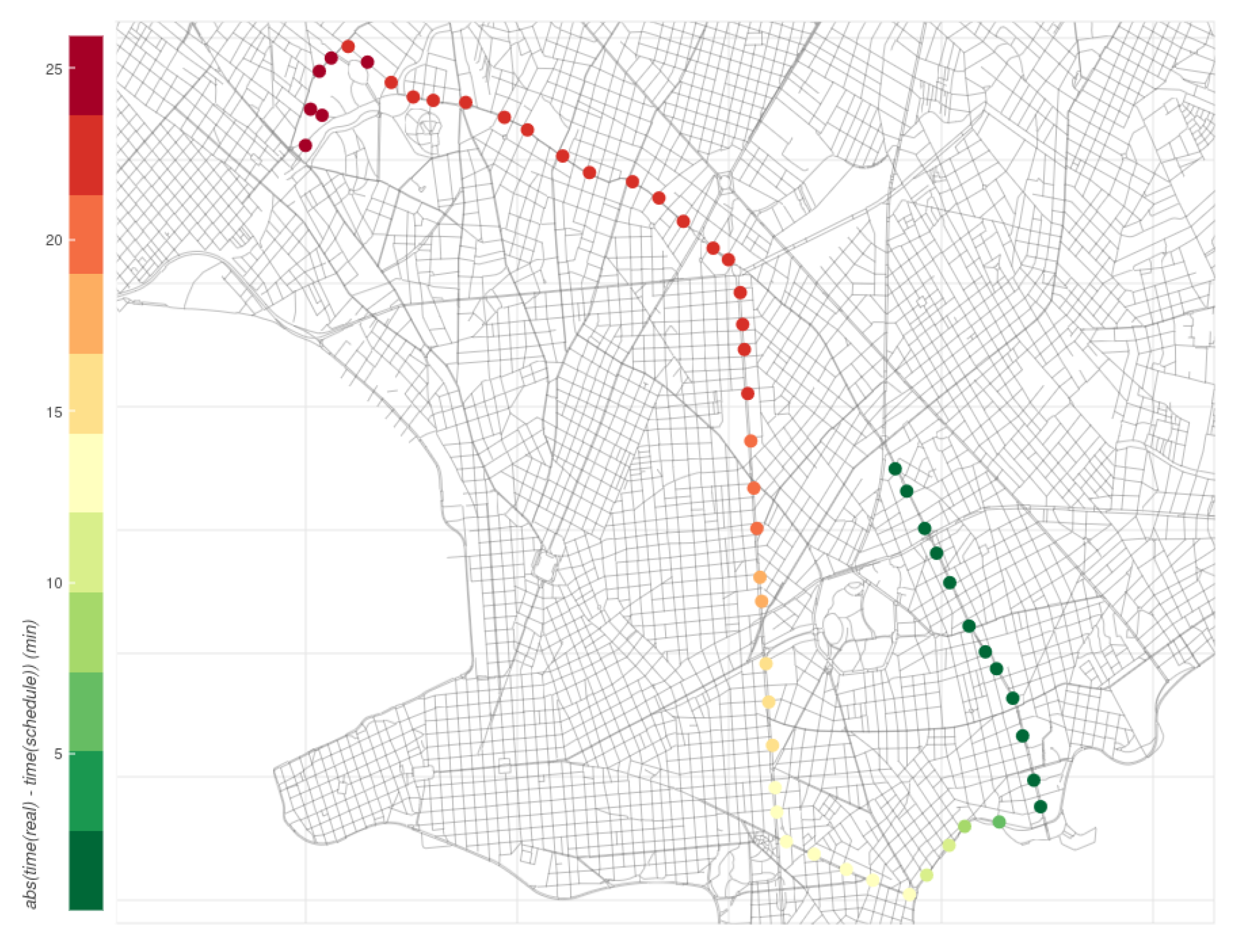
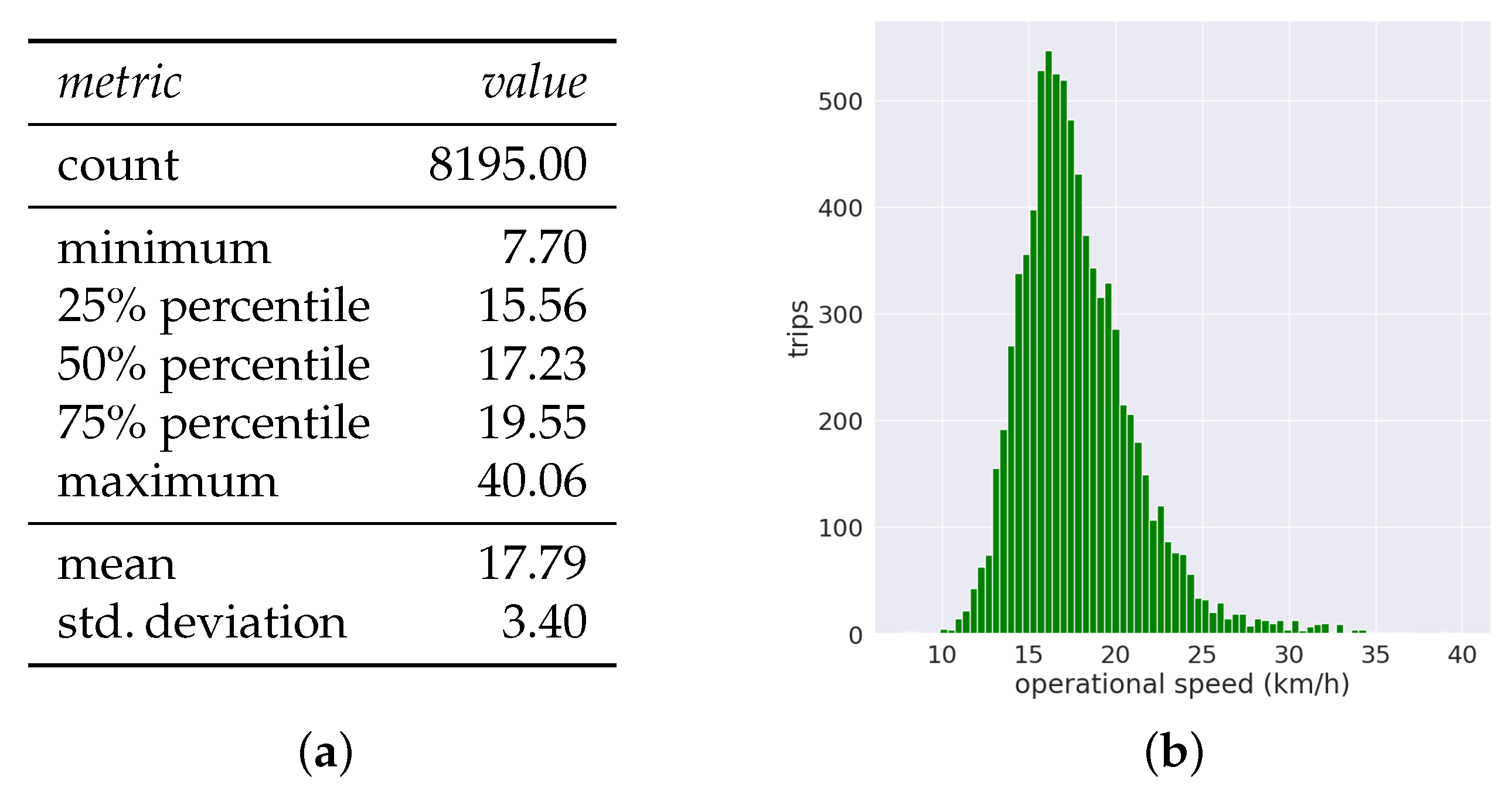
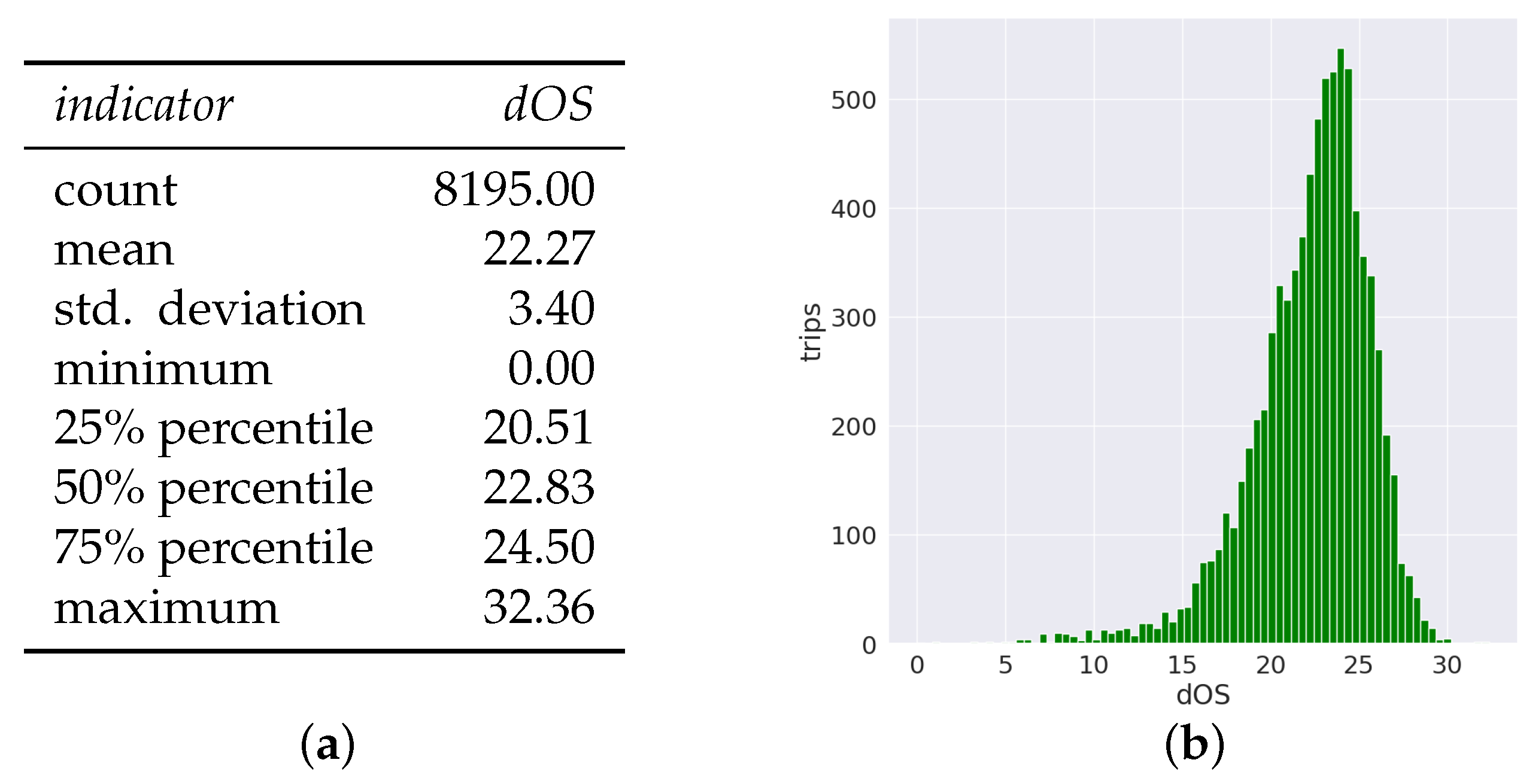
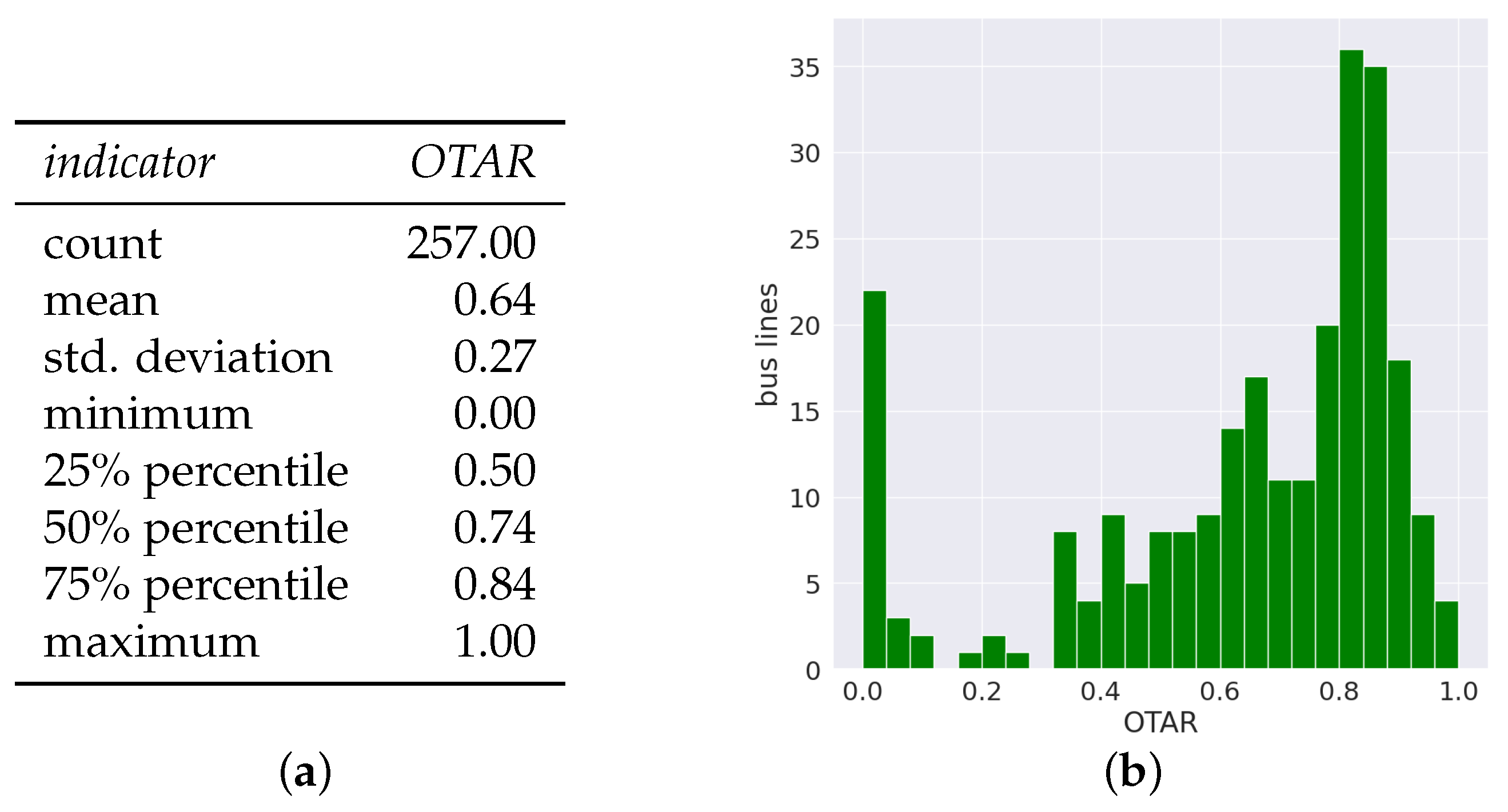
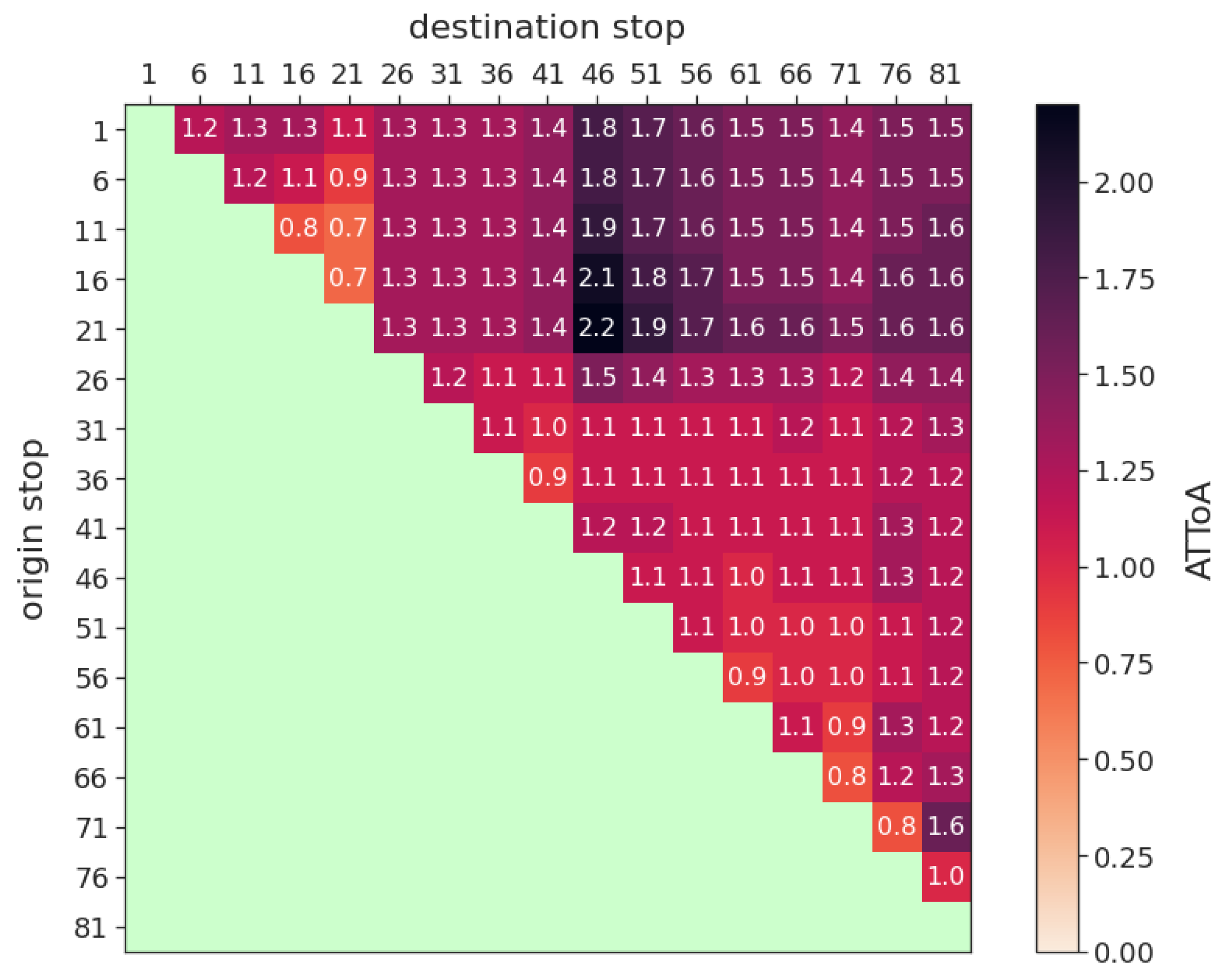
| Avenue | Lines | Delay (s) | Mean Headway | Percentage | ||
|---|---|---|---|---|---|---|
| Rush Hours | Non-Peak | Rush Hours | Non-Peak | |||
| 18 de Julio | 38 | 116.91 | 115.77 | 842.86 | 13.9% | 13.7% |
| 8 de Octubre | 28 | 111.38 | 95.17 | 883.63 | 12.6% | 10.8% |
| Camino Carrasco | 14 | 95.60 | 77.69 | 913.59 | 10.5% | 8.5% |
| Luis Alberto de Herrera | 12 | 79.34 | 66.21 | 608.66 | 13.0% | 10.9% |
| Bulevar Artigas | 34 | 91.48 | 85.33 | 691.85 | 13.2% | 12.3% |
| Bulevar España | 12 | 92.77 | 75.17 | 882.77 | 10.5% | 8.5% |
| Avenue | Lines | Delay (s) | Mean Headway | Percentage | ||
|---|---|---|---|---|---|---|
| Weekend | Weekdays | Weekend | Weekdays | |||
| 18 de Julio | 38 | 115.51 | 115.11 | 1051.88 | 11.0% | 10.9% |
| 8 de Octubre | 28 | 101.32 | 110.50 | 1081.22 | 9.4% | 10.2% |
| Camino Carrasco | 14 | 84.96 | 111.97 | 1154.76 | 7.4% | 9.7% |
| Luis Alberto de Herrera | 12 | 71.91 | 74.91 | 707.75 | 10.2% | 10.6% |
| Bulevar Artigas | 34 | 87.59 | 75.44 | 847.61 | 10.3% | 8.9% |
| Bulevar España | 12 | 83.72 | 70.95 | 956.66 | 8.8% | 7.4% |
| Line 109 | Line 181 | ||||
|---|---|---|---|---|---|
| Avenue | Delay (s) | Headway | Avenue | Delay (s) | Headway |
| 18 de Julio | 134.82 | 804.55 | Luis Alberto de Herrera | 53.24 | 384.83 |
| Camino Carrasco | 105.85 | 915.67 | Bulevar Artigas | 60.39 | 378.97 |
| 8 de Octubre | 93.09 | 936.53 | Bulevar España | 57.52 | 372.65 |
| Avenue | OTAR Buffer | Significant Delay | ||
|---|---|---|---|---|
| 2 min | 4 min | 5 min | ||
| 18 de Julio | 84.97% | 95.51% | 98.79% | 2.21% |
| Camino Carrasco | 87.08% | 95.65% | 98.50% | 1.50% |
| 8 de Octubre | 89.44% | 96.26% | 98.83% | 1.17% |
| Luis Alberto de Herrera | 88.74% | 95.53% | 98.81% | 1.19% |
| Bulevar Artigas | 84.78% | 94.80% | 97.76% | 2.24% |
| Bulevar España | 91.04% | 96.96% | 98.90% | 1.10% |
| Indicator | Buffer |
|---|---|
| count | 257.00 |
| min | 0.00 |
| 25% | 0.08 |
| 50% | 0.11 |
| 75% | 0.14 |
| max | 0.38 |
| mean | 0.11 |
| std | 0.06 |
Disclaimer/Publisher’s Note: The statements, opinions and data contained in all publications are solely those of the individual author(s) and contributor(s) and not of MDPI and/or the editor(s). MDPI and/or the editor(s) disclaim responsibility for any injury to people or property resulting from any ideas, methods, instructions or products referred to in the content. |
© 2023 by the authors. Licensee MDPI, Basel, Switzerland. This article is an open access article distributed under the terms and conditions of the Creative Commons Attribution (CC BY) license (https://creativecommons.org/licenses/by/4.0/).
Share and Cite
Nesmachnow, S.; Massobrio, R.; Guridi, S.; Olmedo, S.; Tchernykh, A. Big Data Analysis for Travel Time Characterization in Public Transportation Systems. Sustainability 2023, 15, 14561. https://doi.org/10.3390/su151914561
Nesmachnow S, Massobrio R, Guridi S, Olmedo S, Tchernykh A. Big Data Analysis for Travel Time Characterization in Public Transportation Systems. Sustainability. 2023; 15(19):14561. https://doi.org/10.3390/su151914561
Chicago/Turabian StyleNesmachnow, Sergio, Renzo Massobrio, Santiago Guridi, Santiago Olmedo, and Andrei Tchernykh. 2023. "Big Data Analysis for Travel Time Characterization in Public Transportation Systems" Sustainability 15, no. 19: 14561. https://doi.org/10.3390/su151914561







